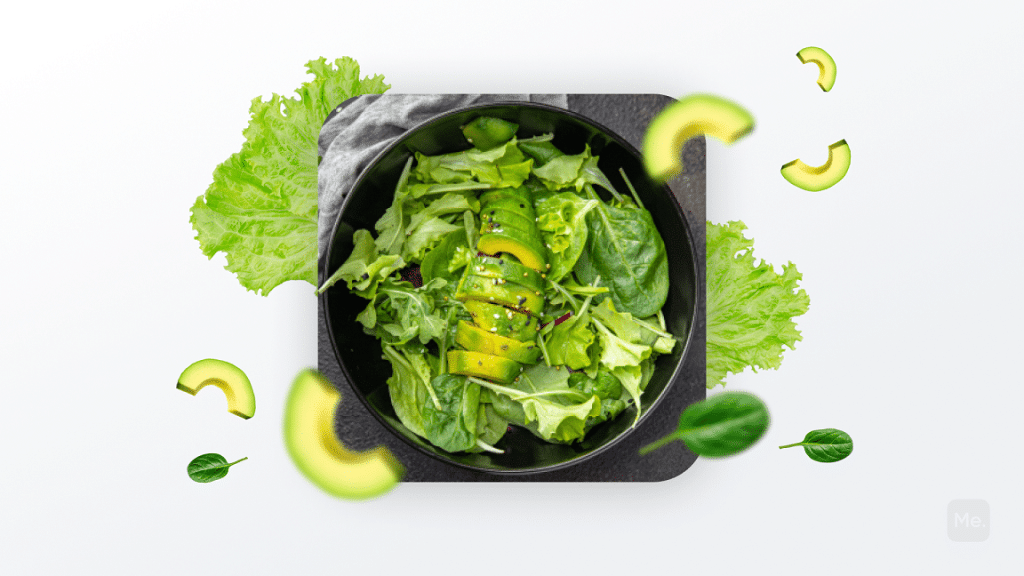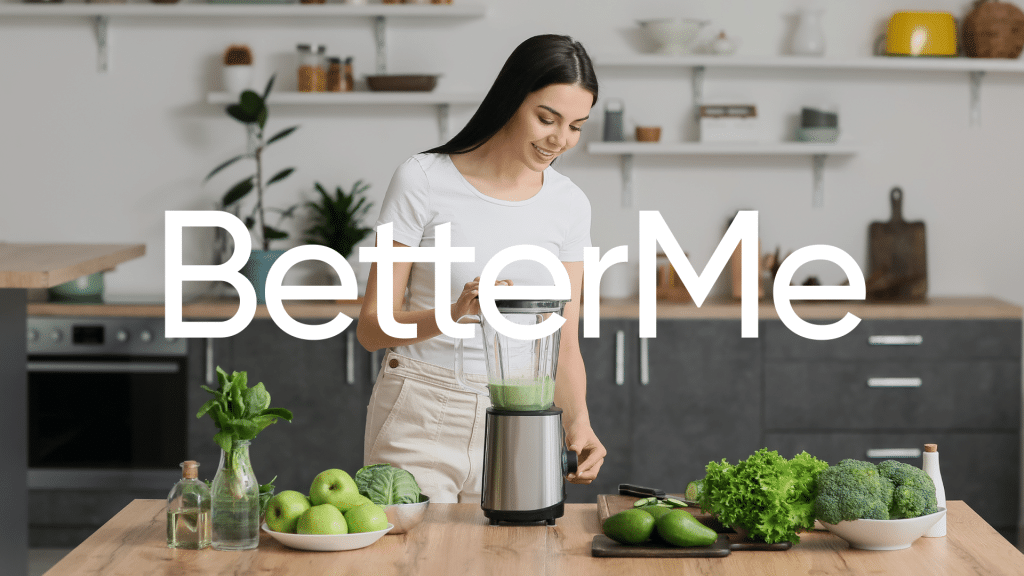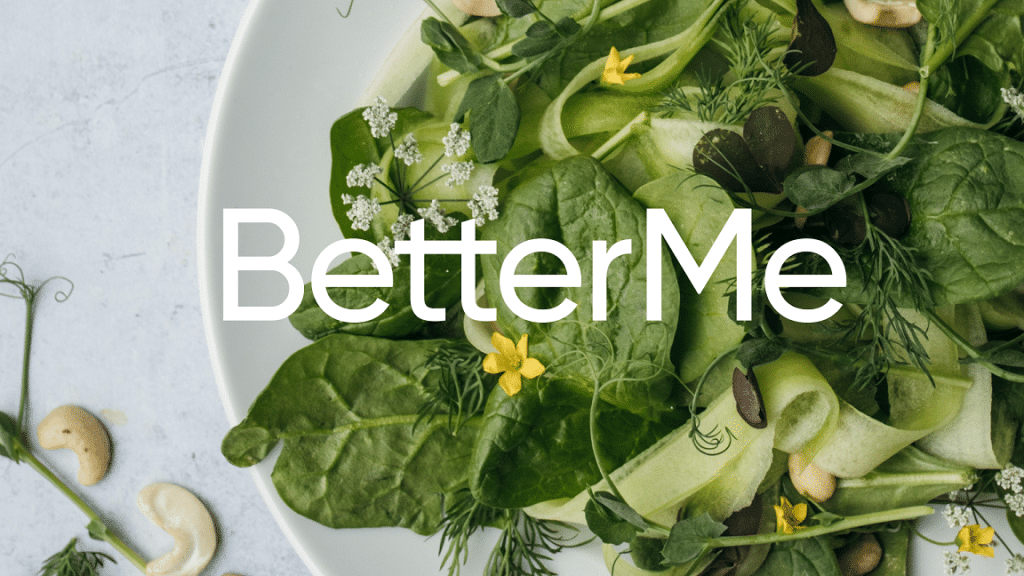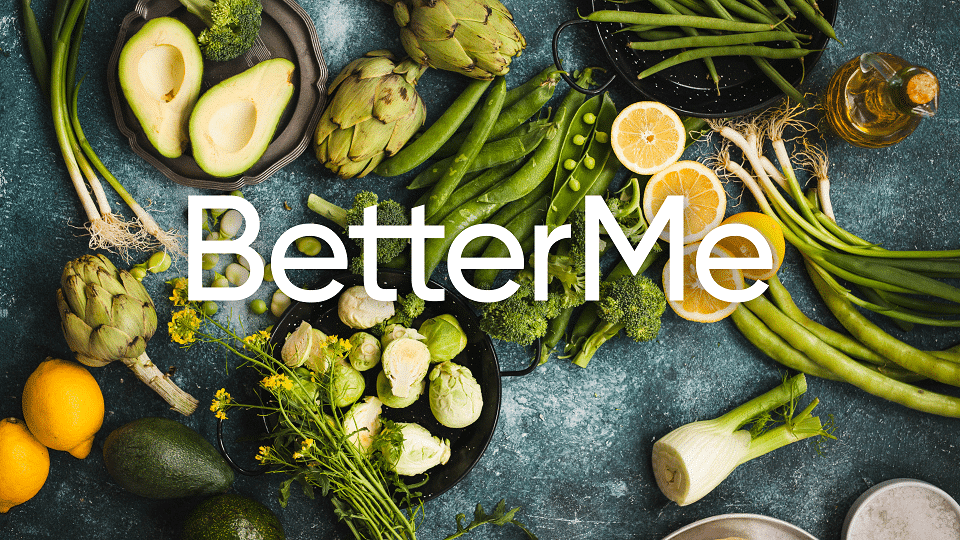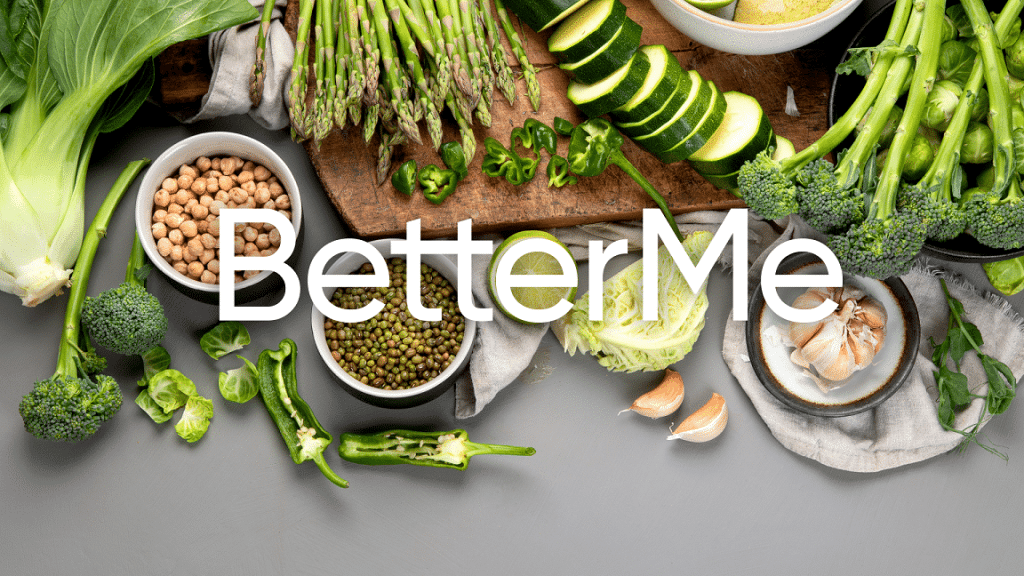A healthy lifestyle starts with what’s on your plate. You need a balanced diet of proteins, carbohydrates, vitamins, and minerals. Green leafy vegetables are a great place to start since they are low in calories and are packed with essential minerals, vitamins, and fiber.
Get your personalized
meal plan!
Leafy greens, also called leafy vegetables or vegetable greens, are plant leaves consumed as vegetables. Although not all plant leaves are edible, there are a ton of them that you can eat and reap numerous nutritional benefits. If your nutritional expert has suggested that you add more dark greeny leafy vegetables to your diet, you better do so.
What Vitamins Are Supplied By Dark Green Leafy Vegetables?
If you’re wondering ‘why to eat green leafy vegetables?’, here’s your answer.
Green leafy vegetables are nutritional powerhouses. These vegetables are packed with numerous vital nutrients that you need. Greens are a great source of vitamin A, C, K, E, and B vitamins (13).
Plus, these vegetables have an abundance of carotenoids-antioxidants that serve to protect cells and may also be associated with lowering the risk of several types of cancer (8).
So, what are green leafy vegetables benefits?
Read More: Eating Before Workout: The Best and Worst Foods For Pre-Workout Nutrition
Vitamin B
Vitamin B complex comprises eight B vitamins: folate, thiamine, riboflavin, niacin, pantothenic acid, pyridoxine, biotin, and cobalamin (3).
Each of these vitamins plays a significant role in your overall body health. The benefits of vitamin B complex include good eyesight, growth of red blood cells, good digestion, healthy brain function, cardiovascular health, proper nerve function, and energy metabolism (3).
Vitamin K
Vitamin K is critical in blood clotting, bone health, and may even be linked with improved episodic memory, especially in older adults (36).
The average daily recommended amount of vitamin K depends on the age of an individual. For adults, the recommended daily intake is 120mcg for men and 90mcg for women. Pregnant women also require 90mcg (35).
Vitamin A
For Vitamin A ( carotene), the deeper the green or orange a vegetable is, the higher the amount of carotene it contains. The human body cannot manufacture its own vitamin A (31).
Vitamin A is necessary for many physiological processes in the body, such as maintaining all surface tissues like the skin, lining of the gut, respiratory tract, inner ear, and the eye (37).
The recommended daily intake of vitamin A is 900mcg for men and 700 mcg for women. Lack of adequate vitamin A in the body is known as vitamin A deficiency (VAD). Vitamin A deficiency makes the body susceptible to infections, increases the risk of diarrhea in children, and is the leading cause of preventable blindness in children (31).
Vitamin E
Alpha-tocopherol is the only form of Vitamin E that meets human requirements (33).
This vitamin is absorbed in the small intestines and stored in the liver. It is a powerful antioxidant that helps maintain healthy cells. Furthermore, this vitamin inhibits platelet aggregation and protects against chronic diseases such as heart disease and cancer (33).
The recommended daily intake of vitamin E is dependent on the age of the person. For adults, the recommended daily amount is 15mg. It is very rare to consume excess vitamin E in food. However, ingesting high doses of alpha-tocopherol supplements is dangerous and can lead to poor blood coagulation and even hemorrhage (33, 34).
Vitamin C
Vitamin C, also called Ascorbic Acid, is a water-soluble vitamin found in most fruits and vegetables. This vitamin can also be synthesized in the laboratory (32).
Whenever you talk of vitamin C, most people think about skin health. Nonetheless, there are other benefits of this vitamin, such as improved immunity, stimulating collagen synthesis, enhanced brain function, and good eye health (32).
Adult males need 90 mg of vitamin C, while females need 75mg. For pregnant and lactating mothers, the recommended daily allowance is 85mg and 120 mg, respectively (32).
A deficiency of this vitamin causes scurvy which is characterized by gum inflammation and bleeding. Low intake of Vitamin C can also contribute to anaemia since this vitamin aids in the absorption of iron.
Yanking yourself back in shape has never been so easy with our game-changing fitness app! Start transforming your life with BetterMe!
Best Green Leafy Vegetables One Should Eat
Leafy green vegetables are a must-have in your diet. These foods brim with fiber, vitamins, and, to top it all, are low in calories.
Green leafy vegetables benefit you in numerous ways. For instance, if you eat a healthy portion of these vegetables daily, you protect yourself from many diseases such as cancer and heart disease. You also strengthen your immunity while at it.
Here is your ultimate green leafy vegetables list:
Spinach
It is very rare to find a bowl of vegetable salad lacking spinach. You may not be a fan of spinach, but once you realize the heap of benefits that this vegetable has, you will quickly incorporate it into your diet.
For one, spinach is packed with several nutrients. For every 100grams of spinach, you have carbs (3.6g), proteins (2.85g), vitamin C (26.5mg), vitamin A (283 micrograms) as carotenoid, Thiamin (0.077mg), Niacin (0.551mg) and more (26).
Spinach is also rich in fiber which helps in digestion (19).
In addition to this, spinach also contains a ton of minerals valuable to the body (27). These minerals include:
- Iron
- Calcium
- Magnesium
- Potassium
Health Benefits Of Spinach
Spinach has numerous health benefits. Here are some of them.
- May help reduce blood sugar.
- Aids in good bone health (14).
- Helps in weight loss.
- May reduce and help manage hypertension (15).
- Has anti-inflammatory properties (18).
Serving suggestions of spinach are numerous. You may choose to eat it raw in salads and smoothies, or you can simply saute it and serve it creamed with bacon.
Read More: 6 Meals A Day: Saying Goodbye To The ‘Less Is More’ Diet Mentality
Collard Greens
Collard greens are a cruciferous vegetable that you need to add to your diet because of their numerous benefits. They are members of the cabbage family and hence have the same texture as kale and cabbages.
As is with most vegetables, collard greens are low in calories but packed with vitamins and minerals. These vegetables are dark green, a clear indication that they are rich in antioxidants.
For every 100g of collard greens, you have (10):
- Protein (3.02g)
- Carbs (5.42g)
- Fat (0.61g)
- Sugars (0.46g)
This vegetable also contains a ton of minerals such as:
- Calcium (232mg)
- Iron (0.47mg)
- Magnesium (27mg)
The vitamins found in collard greens include vitamin C (35.3mg), Riboflavin(0.13mg), Niacin (0.742mg), and vitamin K (437.1 micrograms).
Health Benefits Of Collard Greens
The nutrients found in collard green have essential health benefits. They include:
- Collard greens are rich in antioxidants that fight free radicals produced by the body. Additionally, this may also reduce the risk of developing cancer (2).
- Contains folate which helps prevent congenital disabilities (17).
- Collectively, all the nutrients contained in collard greens work towards enhancing your immunity. Vitamin C helps maintain your cells while vitamin A maintains the T cells, which help fight disease-causing bacteria (24).
- Improved eye health due to lutein content (29).
To help retain their nutrients, the best way to cook collard greens is by steaming them for a short time.
Bok Choy
Also called pak choi or Chinese cabbage, this vegetable is a superfood. It is also cruciferous, like spinach and collard greens. It has thick, crunchy stems and broad green leaves. This is quite different from other vegetables in the cabbage family, which tend to have “heads.”
This vegetable is not only delicious but also rich in beneficial nutrients. For every 100grams of bok choy, you have (6):
- Protein (1.5g)
- Fat (0.2g)
- Water (95.3g)
- Energy (13 kcal/55 kj)
Bok choy also has a ton of minerals such as:
- Calcium (105mg)
- Iron (0.8mg)
- Magnesium (19mg)
This vegetable is also rich in vitamin C (45mg), vitamin K (45.5 micrograms), vitamin A (4470 IU), and vitamin E (0.09mg).
Health Benefits Of Bok Choy
The micronutrient content in bok choy makes it have numerous health benefits.
For instance, it has antioxidants that help protect your body from oxidative stress, helping to prevent various diseases (22).
Other benefits associated with this vegetable include:
- Anti-cancer properties: Being cruciferous, bok choy has potential anti-cancer properties. This is because they have sulfur-containing compounds such as glucosinolates which may have anti-cancer benefits (12).
- Bok choy has an abundance of minerals such as potassium and magnesium that work to regulate and stabilize your blood pressure. Moreover, bok choy is a good source of folate, which helps prevent the build-up of homocysteine. Homocysteine buildup can damage blood vessels which in turn increase the risk of heart disease (21, 23, 16).
- Magnesium, calcium, phosphorus, and zinc found in bok choy all work towards maintaining your healthy bones (38).
If you wish to cinch your waist, tone up your bat wings, blast away the muffin top – our fitness app was created to cater to all your needs! BetterMe won’t give excess weight a chance!
Broccoli
This is also another cruciferous vegetable loaded with beneficial nutrients. 100 grams of broccoli contains (5):
- Proteins (2.57g)
- Fats (0.34g)
- Carbohydrates (6.27g)
- Fiber (2.4g)
It also contains minerals such as:
- Calcium
- Iron
- Magnesium
Health Benefits of Broccoli
- It contains bioactive compounds which have anti-inflammatory properties. These compounds may also serve to prevent cell damage caused by certain diseases such as cancers (4).
- Eating broccoli helps regulate blood sugar. It contains a high fiber content which helps maintain healthy sugar levels and improved diabetic control (19).
- The bioactive compounds in Broccoli may help slow the aging process, support healthy brain function, and help slow mental decline (4).
Swiss Chard
A lot of times, people mistake swiss chard for spinach. This vegetable has large dark green leaves with white or yellow stalks.
They are packed with beneficial nutrients such as vitamin A (6116IU), K (830mcg) and C (30mg). Additionally, it is rich in minerals such as manganese (0.4mg), potassium (379 mg), zinc (0.4mg) and phosphorus (46mg) (9).
Swiss chard is an excellent addition to your diet as it is low in calories, saturated fat and cholesterol. There are numerous benefits tied to this wonder vegetable.
Health Benefits Of Swiss Chard
- It contains syringic acid, which may be helpful for lowering blood pressure (28).
- It is packed with antioxidants such as polyphenols and beta-carotene that help fight free radicals in the body (2).
- Swiss chard has a high fiber content which helps to improve bowel movement, gut health and even stabilizing blood sugar levels.
- It is a weight loss-friendly vegetable since it has low-calorie content.
You can have your swiss chard raw in smoothies or salads. Alternatively, you can simply saute them over low heat. Be careful not to overcook them as some nutrients may be lost.
Turnip Greens
Just like kale and spinach, turnip greens are also cruciferous. You can eat both the roots and the leaves of this vegetable. It is highly nutritious, containing proteins, fats, carbohydrates, fiber and sugar. It is also rich in minerals such as calcium (190 mg), iron(1.10mg) and magnesium (31mg). The leaves of a turnip greens are good sources of vitamins such as A (11587IU), K (251mcg) and C (60mg) (30).
Turnip greens contain a high level of sodium so when cooking, go easy on the salt. You can add just a pinch to taste.
Health Benefits Of Turnip Greens
- Turnip greens have a high vitamin A content that is good for your hair and skin health.
- The vitamin C in this vegetable is essential for collagen production, which is an important skin element.
- You can also eat turnip greens to increase your iron levels.
- Compared to other vegetables, turnip greens contain a significantly higher percentage of calcium hence, perfect for osteoporosis prevention.
Kale
Although kale is a common vegetable, many people don’t know just how many nutrients this super vegetable contains. It is rich in vitamin A (15376 IU), C (120mg) and K (817mcg), essential for a healthy body. It also has protein (3.3g), carbohydrates (10.0g), dietary fiber (2.0g) (20).
Health Benefits Of Kale
Kale has a ton of benefits. They include:
- The fiber in kale helps lower cholesterol which in turn reduces the risk of heart disease.
- This vegetable is also rich in lutein and zeaxanthin, which are essential for good eye health.
- Kale helps in weight loss since it is high in fiber and very low in calories.
The best way to get nutrients from kale is by eating it raw. To make it palatable, include it in your salads or smoothies.
Cabbage
Cabbage comes in various colors, primarily white, purple and green. This vegetable is rich in nutrients such as proteins (1.3g), carbohydrates (5.8g), fiber (2.5g), vitamin B6 (0.1mg) and folate (43mcg) (7).
Health Benefits Of Cabbage
- The high concentration of folate and vitamin B6 in cabbages makes it great for normal functioning of the nervous system and healthy metabolism.
- Red cabbages contain compounds such as anthocyanins which, apart from giving cabbage its red color, may help reduce the risk of heart disease (1).
The Bottom Line
We hope you got your answer to ‘why are green leafy vegetables good for you’. Whether you choose to eat your vegetables raw or cooked, they are an essential addition to your diet. What’s more, these vegetables are readily available, and you can even grow your own.
DISCLAIMER:
This article is intended for general informational purposes only and does not address individual circumstances. It is not a substitute for professional advice or help and should not be relied on to make decisions of any kind. Any action you take upon the information presented in this article is strictly at your own risk and responsibility.
SOURCES:
- Anthocyanin in cardiovascular disease (2011, ncbi.nlm.nih.gov)
- Antioxidants and cancer prevention (2021, foh.psc.gov)
- B vitamins and folic acid (2020, www.nhs.uk)
- Bioactive compounds and bioactivities. (2020. Ncbi.nlm.nih.gov)
- Broccoli, Raw (2019, fdc.nal.usda.gov)
- Cabbage, Chinese (pak-choi),raw (2019, dfc.nal.usda.gov)
- Cabbage, raw (2021, nutritiondata,self.com)
- Carotenoid analysis of several dark green leafy vegetables associated with a lower risk of cancers (1996, pubmed.ncbi.nln.nih.gov)
- Chard, Swiss, raw Nutrition Facts and calories (2021, nutritiondata.self.com)
- Collards, raw (2020, fdc.nal.usda.gov)
- Continuing education activity ( 2020, ncbi.nlm.nih.gov)
- Cruciferous vegetables, dietary phytochemicals for cancer prevention (2013, pubmed.mcbi.nlm.nih.gov)
- Dark green leafy vegetables, (2016, ars.usda.gov)
- Eat spinach to grow strong. (2015, nof.org)
- Effects of spinach, a high dietary nitrate source on arterial stiffness and related hemodynamic measures. (2015, ncbi.nlm.nih.gov)
- Folate (Folic Acid)-Vitamin B9 ( 2021, hsph.harvard.edu)
- Folic acid helps prevent some birth defects (2020,
- Functional properties of spinach (2016, pubmed.ncbi.nlm.nih.gov)
- Health effects of dietary fibre (2014, pubmed.ncbi.nlm.nih.gov)
- Kale, Raw (2021,nutritriondata.self)
- Minerals and blood pressure (1991, pubmend.ncbi.nlm.nih.gov)
- Oxidative stress, aging and diseases (2018,ncbi.nlm.nih.gov)
- Randomized trial of folic acid supplementation and serum homocysteine levels (2001, pubmed.ncbi.nlm.nih.gov)
- Role of Vitamin A in the immune system (2018, ncbi.nlm.nih.gov)
- Selenium (2021, ods.od.nih.gov)
- Spinach, baby (2021,fdc.nal.usda.gov)
- Spinach, Mature 92021, fdc.nal.usda.gov)
- Syringic acid ameliorates-induced hypertension by reducing oxidative stress (2012, pubmed.ncbi.nlm.nih.gov)
- The effect of Lutein on eye and extra eye health (2018, ncbi.nlm.nih.gov)
- Turnip greens, raw (2021, nutritionvalue.org)
- Vitamin A (2021, ods.od.nih.gov)
- Vitamin C (2021, ods.d.nih.gov
- Vitamin E (2021, ods.od.nih.gov)
- Vitamin E toxicity (2021, ncbi.nlm.nih.gov)
- Vitamin K (2021,ods.od.nih.gov)
- Vitamin K status and cognitive functions in healthy older adults (2013, pubmed.ncbi.nlm.nih.gov)
- What is Vitamin A and why do you need it (2013, ncbi.nlm.nih.gov)
- Zinc depletion associates with tissue eosinophilia and collagen depletion in chronic rhinosinutisits (2020, pubmed.ncbi.nlm.nih.gov)



